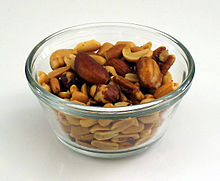Granular convection



The phenomenon in which the biggest particles end up on the surface when a granular material containing a mixture of objects of different sizes is shaken is known as the brazil nut effect. The term was based on the observation that, when a container of mixed nuts is opened after it has been shaken, the brazil nuts tend to be on top. The same effect is seen in packets of breakfast cereal containing particles of different sizes but similar density, such as muesli.
There are several possible explanations for this apparently counter-intuitive effect:
- Smaller particles can fall into the spaces underneath a larger particle after each shake. Over time, the larger particle rises in the mixture. In other words: The center of mass of the whole system (containing the mixed nuts) in an arbitrary state is not optimal (because of the space close to the brazil nuts), it has the tendency to be lower due to gravity. When you shake the nuts, gravity will make sure the center of mass of the system moves down and this can only be done by moving the brazil nuts up. Gravity will also make sure they stay up.
- When shaken, the particles move in vibration-induced convection flow: individual particles move up through the middle, across the surface, and down the sides. If a large particle is involved, it will be moved up to the top by convection flow. Once at the top, the large particle will stay there because the convection currents are too narrow to sweep it down along the wall.
- Including the effects of air in spaces between particles, larger particles may become buoyant or sink.
The effect is of serious interest for some manufacturing operations; once a homogeneous mixture of granular materials has been produced, it is usually undesirable for the different particle types to segregate. Several factors determine the severity of the Brazil nut effect, including the sizes and densities of the particles, the pressure of any gas between the particles, and the shape of a container. A rectangular box (such as a box of breakfast cereal) or cylinder (such as a can of nuts) works well, while a cone-shaped container results in what is known as the reverse brazil nut effect.
